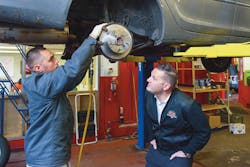Brian Moak, owner of HEART Certified Auto Care, finds it interesting how, as a shop owner, you can get used to something—such as your shop’s operations—especially when that “something” is happening across all your locations. It’s unbelievable, he says, how quickly you can jump to thinking, “That’s just the way it is.”
Moak’s “something” turned out to be major cash flow issues, but he quickly realized that his problem wasn’t just money—it was lack of process. It wasn’t until Moak took a general business seminar where he realized something was wrong, which lead him to fully evaluate the structure of his business.
After taking action, Moak was able to turn his $9.3 million business around, leading to a significant increase in his net profit and overall better tracking of his progress.
The Backstory
Growing up in the industry, Moak has worked in his family business since he was 16 years old. Formerly Duxler Complete Auto Care, Moak, who became full owner of the business in 2015, changed the name to HEART Certified Auto Care in 2017. The operation has three locations in Illinois.
Moak was working 80 hours per week, involved in every transaction and piece of the operation, and called himself more of an “operator” at the time versus an owner.
Because of his heavy involvement, Moak couldn’t understand why, at one point, his business wasn’t making as much money as it should, causing him to take a deeper look into what was going on.
The Problem
In August 2015, Moak began realizing that his business was turning out a lot of work, but the finances did not necessarily reflect that success. That got him thinking, “where is the bottom line benefit?”
There were daily cash flow issues, which, according to Moak, caused the business to live “day to day.” In 2015, the business was making 35–40 percent gross profit and only 3 percent net profit overall, reflecting nowhere near the amount of work that was being done.
This drove Moak to do a top-to-bottom audit on his entire business where he realized that his finances were a symptom of a larger problem, namely having goals with no outcome. That proved to be the root cause of the prominent issues he was experiencing. There weren’t any hard numbers or targets to hit to ensure that goals were met. There was a lot of freedom and flexibility for the salesperson to sell the job for “what they believed” they could get it for, resulting in discounted pricing.
After a month of studying his weaknesses, in September 2015, Moak designed a large-scale plan to change things around and started implementation in June 2016.
The Solution
His implementation plan started with three things that had the biggest impact on fixing his problem: adding two point-of-sales systems, a management system, and creating a “dashboard” that is an extensive report outlining sales and shop performance.
The Systems. Moak spent six months researching different systems before deciding which one to bring in. Moak was looking for ease of use, specifically in tracking results and performance. He also wanted a system that would interact with the shopflow management system.
Once he did, he says that first and foremost, it was able to raise the level of accountability in his shop. There was no more guessing what the problems were.
Through the system, everything became trackable. There were set profit margins for parts and the correct labor markups, which are regulated quickly and efficiently. Now, if one of his service advisors enters a discount price, it’s flagged, which allows Moak to track which advisors get flagged the most.
What Moak was particularly happy about was that his sales staff found that they were able to sell work for the standard price, which was more than what they believed they could get customers for. This eliminated constant discounting of services to customers.
The “Dashboard.” The second-largest part of his process was tracking. Moak sat down with a programmer to develop the “dashboard,” an in-depth daily operating summary of how his business is doing.
This process included identifying the critical drivers of his business. The report outlines those KPIs and breaks down the shop’s efficiency and sales and shows a detailed breakdown of how those numbers were achieved.
It shows where the shop is at for the day, week and month in comparison to the last year and in comparison to the standard that Moak has set based on the shop’s growth patterns.
He went from just tracking through monthly financial statement metrics to tracking through daily critical drivers.
Through this dashboard, Moak was able to designate minimum thresholds for each of the 4–5 different categories that should be met, as well as targets that he plans to meet, assuming all runs smoothly.
If a certain part of the report doesn’t meet Moak’s minimum requirement, it is highlighted red. The red areas, Moak says, are like a treasure map because using the rest of the report will help you dig deeper into how you can achieve better numbers for the missed category.
The dashboard report is emailed to management and customer service reps and is then hung up in the breakroom on a daily basis.
“There is not a day that goes by where everyone in the company doesn’t know exactly where we are,” he says.
Each of the locations has its own dashboard and has inspired a comparative board to be put up in all the breakrooms to track the progress of each location.
The Aftermath
Since implementing the management systems and the daily tracking report, Moak’s net profit (after expenses, interest, depreciation and taxes) went up to 14 percent year-to-date, an 11 percent increase from the initial 3 percent profit back in 2015.
Once his profit was up, Moak says he was able to make even more changes to the shop in an effort to better the environment for his employees.
Moak made state-of-the-art breakrooms at each location that are fully stocked with snacks. The break rooms are also utilized for training as they also have computers and a big screen TV. Moak says that on their downtime, they can always be increasing their knowledge.
He even restructured his staff’s compensation plan.
“We’ve added 13 percent to gross profit,” he says. “Our mechanics are making more than they ever did before and we are making more than we ever did before.”
Moak created a higher floor rate for his flat-rate techs, who were previously salaried, and the sales team has various incentive-based plans that increase depending on volume, gross profit and customer satisfaction.
Moak now boasts a combined monthly car count of 2,100 with 42 people employed across all locations.
More importantly, Moak says that now he can manage alongside his management team and truly be an owner. He’s now working 40 hours per week and watching his company grow, experiencing 10 percent company growth since 2015.
The Takeaway
Moak says that now, the company doesn’t have goals, it has standards, something he believes to be a stronger indication of growth.
But even better, his staff is also invested in the changes that were made.
“I’m so proud of how focused everyone is,” Moak says. “Nobody owns success, we rent it; and the rent is due every day.”
SHOP STATS: HEART Certified Auto Care Location: THREE LOCATIONS IN EVANSTON, NORTHBROOK AND WILMETTE, ILL. Operator: Brian Moak Average Monthly Car Count: 2,100 (combined) Staff Size: 42 (combined) Shop Size: 7,200 square feet (Evanston); 4,800 square feet (Northbrook); 3,900 square feet (Wilmette); Annual Revenue: $9.3 million (combined)



